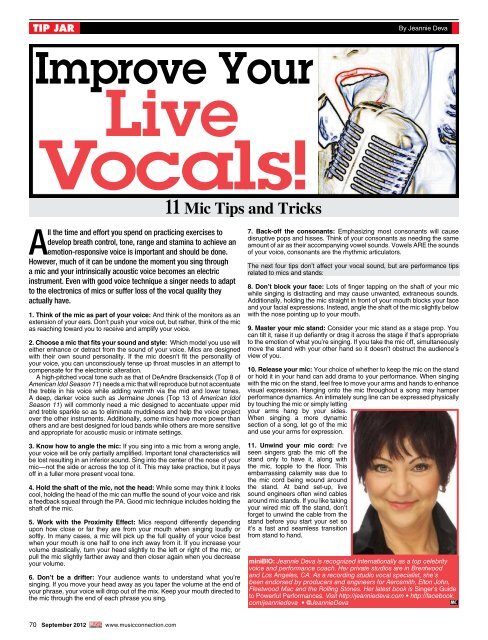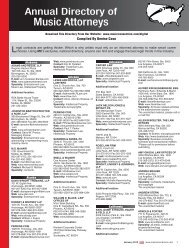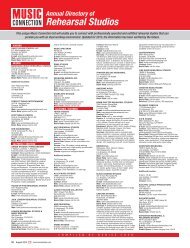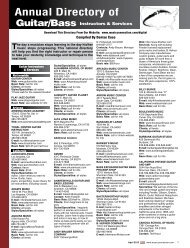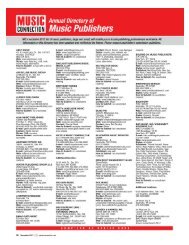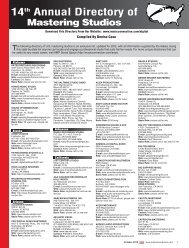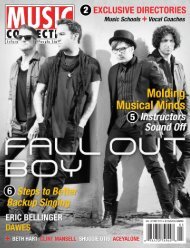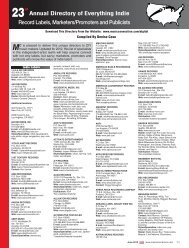TruSource Technology DL2 Integrated Digital Mixer
September 2012 - Music Connection
September 2012 - Music Connection
- No tags were found...
You also want an ePaper? Increase the reach of your titles
YUMPU automatically turns print PDFs into web optimized ePapers that Google loves.
TIP JAR<br />
By Jeannie Deva<br />
Improve Your<br />
Live<br />
Vocals!<br />
11 Mic Tips and Tricks<br />
All the time and effort you spend on practicing exercises to<br />
develop breath control, tone, range and stamina to achieve an<br />
emotion-responsive voice is important and should be done.<br />
However, much of it can be undone the moment you sing through<br />
a mic and your intrinsically acoustic voice becomes an electric<br />
instrument. Even with good voice technique a singer needs to adapt<br />
to the electronics of mics or suffer loss of the vocal quality they<br />
actually have.<br />
1. Think of the mic as part of your voice: And think of the monitors as an<br />
extension of your ears. Don’t push your voice out, but rather, think of the mic<br />
as reaching toward you to receive and amplify your voice.<br />
2. Choose a mic that fits your sound and style: Which model you use will<br />
either enhance or detract from the sound of your voice. Mics are designed<br />
with their own sound personality. If the mic doesn’t fit the personality of<br />
your voice, you can unconsciously tense up throat muscles in an attempt to<br />
compensate for the electronic alteration.<br />
A high-pitched vocal tone such as that of DeAndre Brackensick (Top 8 of<br />
American Idol Season 11) needs a mic that will reproduce but not accentuate<br />
the treble in his voice while adding warmth via the mid and lower tones.<br />
A deep, darker voice such as Jermaine Jones (Top 13 of American Idol<br />
Season 11) will commonly need a mic designed to accentuate upper mid<br />
and treble sparkle so as to eliminate muddiness and help the voice project<br />
over the other instruments. Additionally, some mics have more power than<br />
others and are best designed for loud bands while others are more sensitive<br />
and appropriate for acoustic music or intimate settings.<br />
3. Know how to angle the mic: If you sing into a mic from a wrong angle,<br />
your voice will be only partially amplified. Important tonal characteristics will<br />
be lost resulting in an inferior sound. Sing into the center of the nose of your<br />
mic––not the side or across the top of it. This may take practice, but it pays<br />
off in a fuller more present vocal tone.<br />
4. Hold the shaft of the mic, not the head: While some may think it looks<br />
cool, holding the head of the mic can muffle the sound of your voice and risk<br />
a feedback squeal through the PA. Good mic technique includes holding the<br />
shaft of the mic.<br />
5. Work with the Proximity Effect: Mics respond differently depending<br />
upon how close or far they are from your mouth when singing loudly or<br />
softly. In many cases, a mic will pick up the full quality of your voice best<br />
when your mouth is one half to one inch away from it. If you increase your<br />
volume drastically, turn your head slightly to the left or right of the mic, or<br />
pull the mic slightly farther away and then closer again when you decrease<br />
your volume.<br />
6. Don’t be a drifter: Your audience wants to understand what you’re<br />
singing. If you move your head away as you taper the volume at the end of<br />
your phrase, your voice will drop out of the mix. Keep your mouth directed to<br />
the mic through the end of each phrase you sing.<br />
7. Back-off the consonants: Emphasizing most consonants will cause<br />
disruptive pops and hisses. Think of your consonants as needing the same<br />
amount of air as their accompanying vowel sounds. Vowels ARE the sounds<br />
of your voice, consonants are the rhythmic articulators.<br />
The next four tips don’t affect your vocal sound, but are performance tips<br />
related to mics and stands:<br />
8. Don’t block your face: Lots of finger tapping on the shaft of your mic<br />
while singing is distracting and may cause unwanted, extraneous sounds.<br />
Additionally, holding the mic straight in front of your mouth blocks your face<br />
and your facial expressions. Instead, angle the shaft of the mic slightly below<br />
with the nose pointing up to your mouth.<br />
9. Master your mic stand: Consider your mic stand as a stage prop. You<br />
can tilt it, raise it up defiantly or drag it across the stage if that’s appropriate<br />
to the emotion of what you’re singing. If you take the mic off, simultaneously<br />
move the stand with your other hand so it doesn’t obstruct the audience’s<br />
view of you.<br />
10. Release your mic: Your choice of whether to keep the mic on the stand<br />
or hold it in your hand can add drama to your performance. When singing<br />
with the mic on the stand, feel free to move your arms and hands to enhance<br />
visual expression. Hanging onto the mic throughout a song may hamper<br />
performance dynamics. An intimately sung line can be expressed physically<br />
by touching the mic or simply letting<br />
your arms hang by your sides.<br />
When singing a more dynamic<br />
section of a song, let go of the mic<br />
and use your arms for expression.<br />
11. Unwind your mic cord: I’ve<br />
seen singers grab the mic off the<br />
stand only to have it, along with<br />
the mic, topple to the floor. This<br />
embarrassing calamity was due to<br />
the mic cord being wound around<br />
the stand. At band set-up, live<br />
sound engineers often wind cables<br />
around mic stands. If you like taking<br />
your wired mic off the stand, don’t<br />
forget to unwind the cable from the<br />
stand before you start your set so<br />
it’s a fast and seamless transition<br />
from stand to hand.<br />
miniBIO: Jeannie Deva is recognized internationally as a top celebrity<br />
voice and performance coach. Her private studios are in Brentwood<br />
and Los Angeles, CA. As a recording studio vocal specialist, she’s<br />
been endorsed by producers and engineers for Aerosmith, Elton John,<br />
Fleetwood Mac and the Rolling Stones. Her latest book is Singer’s Guide<br />
to Powerful Performances. Visit http://jeanniedeva.comhttp://facebook.<br />
com/jeanniedeva@JeannieDeva<br />
70 September 2012 www.musicconnection.com


